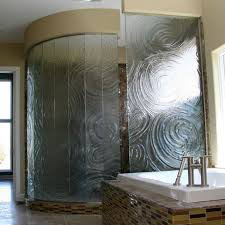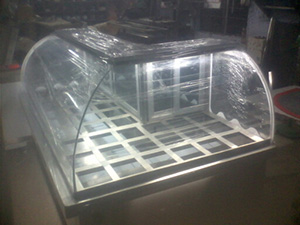
Bent Glasses Variations
Single Bent Glass
Bent glass panels of single glass can be cooled down free of tension, according to the thermal shaping process, so they meet the high technical standards and can be processed into layered safety or insulation glass. The panels cooled without tension can be cut and drilled and the sides can be altered. Single bent glass is mainly applied to small objects for daily use, such as platters, bowls or furniture elements (for instance cupboard doors). Whenever safety and protection is important, Bent safety glass is used. It is often used in lamps and showcases, to show displays for sale, slot machines and numerous smaller, often technically high-quality products.
Layered Bent Glass
Just as it is true for flat glass, curved glass can have a safety function because an intermediate layer of synthetic material is applied between two panels. Most glass types can be processed into layered safety glass, but also in curved shape. Interesting decorative, but also functional, possibilities arise from the large diversity of the available “Interlayers”. In other words, the diversity of the products can be integrated into the synthetic intermediate layer and therefore add an esthetic aspect to safety. Where safety and protection from cuts in possible glass fractures plays a role, curved layered safety glass is required. It is especially used for: railings, façade elements, glass in elevators, doors, ceiling glass, windshields, bullet and explosion proof glass.

Bent Insulation Glass
Similar to the flat insulation glass, curved insulation glass can also be manufactured. The insulation function is reached because two curved panels with a hollow filled with air are assembled by means of a frame. This “built-in” layer of air has an insulating function. Nowadays, this effect is reinforced by the fact that people do not merely use curved glass that is covered in a special layer, which poorly reflects or conducts the heat, but also fills the intermediate space with special gasses that do not let in much heat.

Curved glass links freedom in architectural design to the advantages and qualities of glass products. Curving the glass concerns a processing in which a flat glass panel is heated in a controlled way. Gravity forces the glass to curves and assume the shape of the underlying mold. Curved glass is often used as roof glazing in light domes, porches and shopping galleries, to round the corners of curtain walls or façades corners, as part of furniture, staircases, curved automated doors or shower screens.
Bending Glass
The glass is highly flexible at a high temperature in the infrared range. All conceivable shapes can be realized with special moulds and the right know-how.